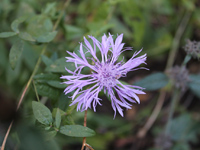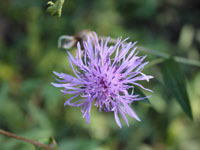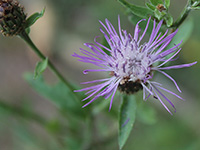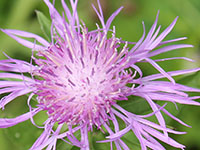![]()
Spotted Knapweed is a invasive biannual or short lived perennial in the aster family. Spotted Knapweed is native to central Europe and east to central Russia. The plant was introduced into North America in the late 1800s as a contaminant of alfalfa or clover seed. Spotted knapweed may also have been introduced through soil used as ship ballast. The plant is found throughout the western United States and Canada although there is evidence that knapweed is rapidly spreading towards the East coast.
![]()
Although spotted knapweed is considered severely invasive; use has been found as a grazing plant for sheep.
![]() Within the realm of naturopathic medicine and folklore, the roots and seeds of spotted knapweed are diaphoretic, diuretic, tonic and vulnerary. The plant once had a very high reputation as an ingredient of the Medieval 'salve', an ointment applied to heal wounds and treat skin infections.
Within the realm of naturopathic medicine and folklore, the roots and seeds of spotted knapweed are diaphoretic, diuretic, tonic and vulnerary. The plant once had a very high reputation as an ingredient of the Medieval 'salve', an ointment applied to heal wounds and treat skin infections.
Please note that MIROFOSS does not suggest in any way that plants should be used in place of proper medical and psychological care. This information is provided here as a reference only.
![]()
There is currently no confirmed data on the edibility of spotted knapweed.
Please note that MIROFOSS can not take any responsibility for any adverse effects from the consumption of plant species which are found in the wild. This information is provided here as a reference only.
![]()
Spotted Knapweed grows in meadow, cultivated beds, and thrives in recently disturbed soil. Spotted Knapweed is suitable for: light (sandy), medium (loamy) and heavy (clay) soils, prefers well-drained soil and can grow in nutritionally poor soil. Suitable pH: acid, neutral and basic (alkaline) soils and can grow in very alkaline soils. Spotted Knapweed cannot grow in the shade. It prefers dry or moist soil and can tolerate drought.
| Soil Conditions | |
| Soil Moisture | |
| Sunlight | |
| Notes: |
![]()
Spotted Knapweed is a perennial with highly branched, wiry-stemmed, hairy stalks which can grow up to 90cm tall. The leaves are a pale grayish-green. They are covered in fine short hairs. First year plants produce a basal rosette, alternate, up to 150mm long, deeply divided into lobes. The plant produces a stem in its second year of growth. Stem leaves are progressively less lobed, getting smaller toward the top. The stem is erect or ascending, slender, hairy and branching, and can grow up to one meter tall. During the summer spotted knapweed plants have multiple violet to lavender rayless flowers. Spotted Knapweed is very hardy and easily overpowers other nearby plant species with a tap root that sucks up water faster than the root systems of its neighbors and releasing a toxin from its roots that stunts the growth of nearby plants of other species. Spotted Knapweed also produces a large number of seeds which ripen from August to October and can easily be spread. Its seed is an achene about a quarter of an inch long, with a small bristly pappus at the tip which makes the wind its primary means of dispersal. The flowers are hermaphrodite (have both male and female organs) and are pollinated by bees, flies, lepidoptera, and by self. The plant is self-fertile.
![]()
| Plant Height | 30cm to 100cm | 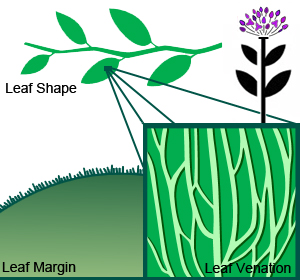 |
| Habitat | Roadsides, fields, freshly disturbed soil, and Waste Places | |
| Leaves | 10cm to 20cm long, highly dissected into linear segments | |
| Leaf Margin | Ciliate | |
| Leaf Venation | Longitudinal | |
| Stems | highly branched wiry stems with fine hairs | |
| Flowering Season | June to August | |
| Flower Type | Rounded clusters of flowers 2.5cm wide that are prickly | |
| Flower Colour | lavender to violet | |
| Pollination | Insects, wind, self | |
| Flower Gender | Flowers are hermaphrodite and the plants are self-fertile | |
| Fruit | achene with small bristly pappus | |
| USDA Zone | 4A (-31.7°C to -34.4°C) cold weather limit |
![]()
The following health hazards should be noted when handling or choosing a location to plant spotted knapweed:
 |
SHARP HAZARD |
 |
INVASION ALERT |
![]()
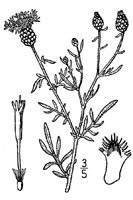 |
-Click here- or on the thumbnail image to see an artist rendering, from The United States Department of Agriculture, of spotted knapweed. (This image will open in a new browser tab) |
![]()
 |
-Click here- or on the thumbnail image to see a magnified view, from The United States Department of Agriculture, of the seeds created by spotted knapweed for propagation. (This image will open in a new browser tab) |
![]()
Spotted Knapweed can be translated into the following select languages:
| Arabic | Bulgarian | вид червена метличина | Chinese (Sim) | 矢车菊 | |
| Croatian | različak | Czech | plevel | Danish | |
| Dutch | Esperanto | Estonian | Kaunokki | ||
| Finnish | kaunokki | French | centaurée | German | Flockenblume |
| Greek | Hebrew | Hungarian | búzavirág | ||
| Italian | fiordaliso | Japanese | ヤグルマギク | Korean | 수레 국화 속 |
| Low Saxon | Lithuanian | Shui | Norwegian | ||
| Persian | قنطوریون اسود | Polish | Portuguese | centáurea-maior | |
| Romanian | Russian | василек | Slovak | burinu | |
| Spanish | Swedish | Tagalog | |||
| Turkish | mor top çiçekli bitki | Ukrainian | волошка | Vietnamese | cây xa cúc |
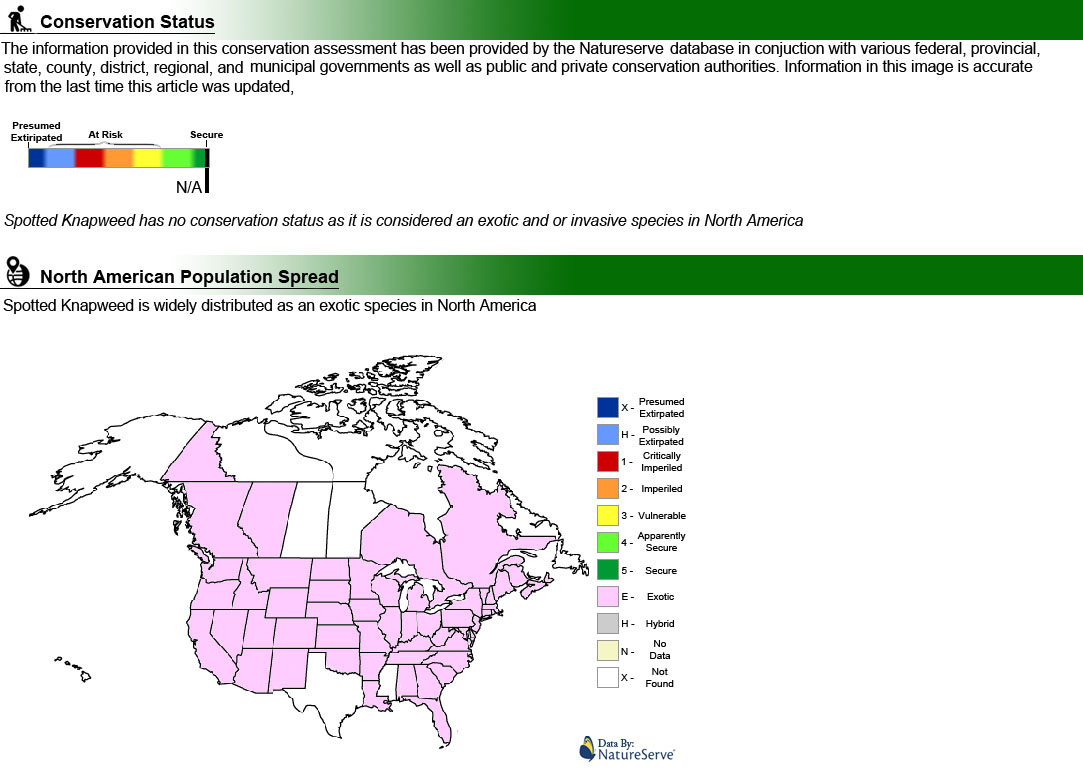
![]()
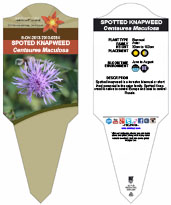 |
The MIROFOSS database offers free printable garden tags for personal and non-profit use. These tags can be used to properly identify plant samples in a garden. Click on the tags shown on the the screen or -click here- to download a full size jpeg image for a spotted knapweed identification tag; which can be printed on paper or used with a plastic laser printer. |
 |
What's this? What can I do with it? |
![]()
| Description / Application | Frost, R. A., & Launchbaugh, K. L. (2003). "Prescription Grazing for Rangeland Weed Management: A New Look at an Old Tool.". Rangelands. |
| Description | DiTomasso, J.M. (2000). "Invasive weeds in rangelands: Species, impacts, and management". Weed Management: 255–265. |
| Folklore | Somers, Paul (2008). A guide to invasive plants in Massachusetts. Massachusetts division of fisheries and wildlife. p. 39 |
| Biology | Roger L. Sheley, James S. Jacobs and Michael F. Carpinelli (April–Jne 1998). "Distribution, Biology, and Management of Diffuse Knapweed (Centaurea diffusa) and Spotted Knapweed (Centaurea maculosa)". Weed Technology: 353–362. |
| Background | John R. Lacey, Clayton B. Marlow and John R. Lane (1989). "Influence of spotted knapweed (centaurea maculosa) on surface runoff and sediment yield". weed technology: 627–631. |
| Biology | Blair, Amy; Nissen, Scott j.; Hufbauer, Ruth A.; Brunk, Galen R. (September 2006). "A Lack of Evidence for an Ecological Role of the Putative Allelochemical (±)-Catechin in Spotted Knapweed". Journal of Chemical Ecology. |
| Biology | Dickinson, T.; Metsger, D.; Bull, J.; & Dickinson, R. (2004) ROM Field Guide to Wildflowers of Ontario, Royal Ontario Museum, Toronto:McClelland and Stewart Ltd. |
| Environment | National Audubon Society. Field Guide To Wildflowers (Eastern Region): Alfred A. Knopf. ISBN 0-375-40232-2 |
| Physical Identification | National Audubon Society. Field Guide To Wildflowers (Eastern Region): Alfred A. Knopf. ISBN 0-375-40232-2 |
| April 02, 2015 | The last time this page was updated |
| ©2025 MIROFOSS™ Foundation | |
 |
|

